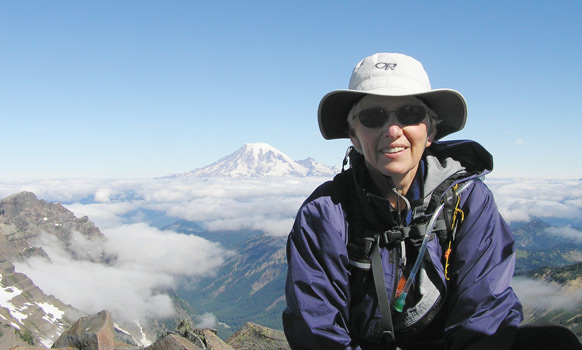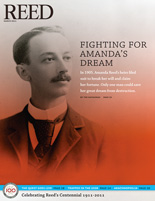
IRIS login | Reed College home Volume 90, No. 1: March 2011
Alumna Profile
By Beverly Karplus Hartline ’71

Smashing Atoms—and Stereotypes
Geoff Koch
Why couldn’t President Bill Clinton urge Congress to pass a law overhauling the periodic table? That’s what a man in Florida was asking in a long letter to the White House. Among his suggestions: wouldn’t it make more sense if the element sodium, now known by the symbol Na, was instead listed as SOD?
The letter made its way to Beverly Karplus Hartline ’71, then an assistant director in the White House Office of Science Technology Policy. Beverly, who for the past decade had managed a half-billion-dollar atom smasher, drafted and mailed a careful reply. The Floridian still wasn’t satisfied—he kept pestering White House operators—so Beverly called him back, a move that flabbergasted her colleagues.
“I believed it was my job,” she says, laughing at the memory.
Today an associate provost at the University of the District of Columbia with a PhD in geophysics, Beverly is well into her fourth decade working to advance the cause of science—which for her increasingly means working to make it easier for women and minorities to pursue scientific careers.
Her motivation stems in part from her own experiences. In 1985 she was named project manager in charge of building the Department of Energy’s Continuous Electron Beam Accelerator Facility in Virginia. The news raised eyebrows in the male-dominated world of accelerator physics, prompting an unprecedented visit by a senior official the weekend after she was named to the position. The visit went fine and CEBAF, as it’s known in physics circles, was completed on time and on budget. Today it’s the heart of Jefferson Lab, which serves more than a thousand scientists in at least 20 countries who are probing the mysteries of the atom.
Beverly is among a handful of outspoken scientists probing an equally difficult question: Why are there so few women and minorities in science? The data are stark. Women hold fewer than 30 percent of tenured or tenure-track science and engineering faculty positions at U.S. universities and colleges, according to the National Science Foundation. And, NSF figures show, black, Hispanic, and American Indian PhDs together make up less than 7 percent of the nation’s total number of working doctorate-holding scientists and engineers.
This imbalance has more to do with subtle cultural biases than overt discrimination, Beverly says. She recalls one physics conference at which a male researcher told her, “You are the smartest secretary I’ve met.”
The key, she believes, is to educate those in positions of power about the subtle biases that plagued the foot-in-mouth physicist, who, she adds, went on to become a colleague and friend.
A bit of fearless gumption can help, too. Beverly cultivated this trait at Reed, which she chose both for its strong science tradition and its wealth of outdoor opportunities, including mountaineering. She was introduced to her husband Fred Hartline ’67 by mountaineer Arlene Blum ’66, and the three are still friends who get together to hike when they can.
Mostly, though, Beverly is found on campus at UDC, Washington’s only public university. The nation’s capital is a great perch from which to speak up with straightforward pragmatism, something Beverly demonstrated when dealing with the cranky chemistry crusader from Florida.
Here’s how that story ends. After politely explaining all the scientific reasons why the periodic table couldn’t be altered, she pointed out that airports also use three-letter codes, which could lead to some confusion. SOD, for example, is already claimed by the Sorocaba Airport in Brazil.
The man thanked her for her perspective and never called again.
Further Reading
Why So Few? How to Increase the Number of Women in Science. Meg Urry, RHIC News, June 3, 2008.
www.bnl.gov/rhic/news/081109/
Women Making Science: Problems, Progress, and Power. Beverly Karplus Hartline.
http://vimeo.com/275058


LATEST COMMENTS
steve-jobs-1976 I knew Steve Jobs when he was on the second floor of Quincy. (Fall...
Utnapishtim - 2 weeks ago
Prof. Mason Drukman [political science 1964–70] This is gold, pure gold. God bless, Prof. Drukman.
puredog - 1 month ago
virginia-davis-1965 Such a good friend & compatriot in the day of Satyricon...
czarchasm - 4 months ago
John Peara Baba 1990 John died of a broken heart from losing his mom and then his...
kodachrome - 7 months ago
Carol Sawyer 1962 Who wrote this obit? I'm writing something about Carol Sawyer...
MsLaurie Pepper - 8 months ago
William W. Wissman MAT 1969 ...and THREE sisters. Sabra, the oldest, Mary, the middle, and...
riclf - 10 months ago